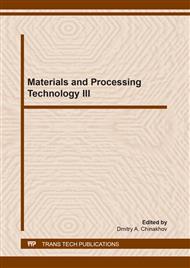[1]
MacKeenzie K G D, Brown I W M, White G V and Eur J 1996Ceram. Soc.V16115-17.
Google Scholar
[2]
Zhuravleva NV, Lukin E.S. 1993 RefractoriesV1 6–11.
Google Scholar
[3]
Bowen NL, Greig JW1924J. Am. Ceram. Soc. V7 238-54.
Google Scholar
[4]
Toropov NA, Galakhov FY 1958Izv. Academy of Sciences of the USSR V1 8–11.
Google Scholar
[5]
Aramaki S, Roy R 1962J. Am. Ceram. Soc. V45 229-42.
Google Scholar
[6]
Ban T, Hayashi S, Yasumori A and Okada K1996 J. Mater. Res V11 1421-27.
Google Scholar
[7]
Zhang С, Zhang F, Cao WS, Chang YA 2010 Intermetallics V18 1419-27.
Google Scholar
[8]
AksayA I Pask J A 1975 J. Am. Ceram. Soc. V58 507-12.
Google Scholar
[9]
Chung J H, Jeong H R. 2012 Ceramics International V38 4601-06.
Google Scholar
[10]
NeshporI.P, Panasyuk A D, Pshenichnaya O V. 2014 Powder Metallurgy and Metal Ceramics V53 7-8.
Google Scholar
[11]
Chen ZY 2005 Beijing Metallurgical Industry Press.
Google Scholar
[12]
Cao G Z, Metselaar R1991Chem. Mater V3 242–52.
Google Scholar
[13]
PartheE1964Gordon and Breach Science Publisher (New York) pp.109-11.
Google Scholar
[14]
Jack KH, Wilson WJ 1972Nature Phys. Sci.V238 28-3.
Google Scholar
[15]
Jack KH,1976 J. Mat. Sci. V11 1135-58.
Google Scholar
[16]
AsakaT, Kudo T,BannoH, FunahashiS and HirosakiN 2013 Powder Diffr V28 171-77.
Google Scholar
[17]
Asaka T, Banno H, Funahashi S, and Hirosaki N 2013 Solid State Chem.V204 21-6.
Google Scholar
[18]
Zuev VV, Kotcheueva LN, Goncharov Y D 2006 Chemistry and Physics of Metals (St. Petersburg LLC ALPHAPOL,) p.139.
Google Scholar
[19]
Pearson W B1972 The Crystal Chemistry and Physics of Metals and Alloys ( New York: Wiley-Interscience)p.806.
Google Scholar
[20]
Panneerselvam M, Rao KJ2003 Mater. Res.B38 663-74.
Google Scholar
[21]
GrigorievON, Dubovik TV, Vinokurov VB and Kotenko VА 2009Refractories and technical ceramics V2 10-5.
Google Scholar
[22]
Toropov NA, Andreev IF, OrlovVA. 1970 Inorganic Materials V6 991-94.
Google Scholar
[23]
Van Dijen FK, Metselaar R, Helmholdt RB 1987J.ofMat. Sci. Let. V6 1101-02.
Google Scholar
[24]
Khvatinskaya DY, Em VT andLoryan VE., 1991 InorganicMaterialsV27 1805-07.
Google Scholar
[25]
Perelyaev VA,Alyamovskii SI, Miroshnikova LD and Fedyukov AS 1988. Inorganic MaterialsV24 799-01.
Google Scholar
[26]
Gillott L,Cowlam N, Bacon GE 1981 J. Mat. Sci. V16 2263-68.
Google Scholar
[27]
Banno H,Asaka T, Fukuda K.2014 Journal of Solid State Chemistry V213 169-75.
Google Scholar
[28]
Banno H,Hanai T,Asaka T, Kimoto K, Nakano H and Fukuda K.2014 Powder Diffraction V29 318-24.
Google Scholar
[29]
Banno H,Hanai T,Asaka T, Kimoto K and Fukuda K 2014 Journal of Solid State Chemistry.V211 124-29.
Google Scholar
[30]
Lindqvist O,Sjöberg J, Hull S,Pompe R 1991 Structural ScienceB47 672-78.
Google Scholar


